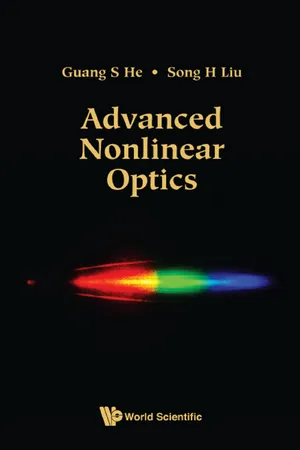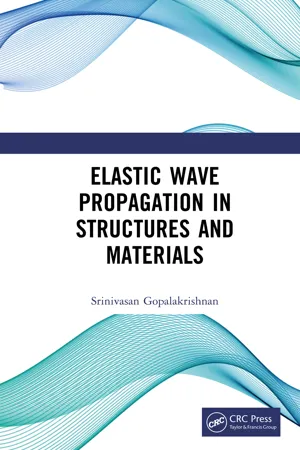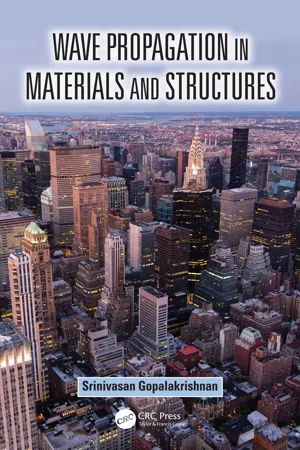Physics
Phase Velocity
Phase velocity refers to the speed at which the phase of a wave propagates through space. It is the rate at which the phase of a wave, such as a light wave or sound wave, changes at a specific point in space over time. Phase velocity is a key concept in wave mechanics and is distinct from group velocity, which describes the speed at which the overall shape of a wave moves.
Written by Perlego with AI-assistance
Related key terms
Related key terms
1 of 4
Related key terms
1 of 3
5 Key excerpts on "Phase Velocity"
- eBook - ePub
- Guang S He, Song H Liu(Authors)
- 2017(Publication Date)
- WSPC(Publisher)
1113.1.1Phase Velocity of a monochromatic light
Phase Velocity, υp(ω), is defined as the propagation speed of the co-phasal surface of a monochromatic continuous light wave with an angular frequency of ω = 2πν. A given monochromatic plane wave propagating along z-axis direction is expressed bywhere E0 (z) is the amplitude function independent of time t,k = 2πn(ω)/λ is the wave number (magnitude of the wave vector), n(ω) is the refractive-index of the medium in which the wave propagates, and λ is the light wavelength in vacuum. In the above expression, the spatiotemporal variation of the wave phase is determined by the phase factor ϕ(t,z) = (ωt − kz), and the moving of the co-phasal plane is determined by the condition ofTaking differential operation on both sides of the above equation leads to kΔz = ωΔt (as k and ω are fixed), and the Phase Velocity is obtained bywhere c is the light velocity in vacuum. In practice, it is impossible to create an ideal monochromatic light wave with infinitesimal spectral linewidth; besides, one cannot use such a monochromatic light wave with infinite time extension to do light speed measurement. Even though the Phase Velocity is not a directly measureable quantity of speed, the refractive index n(ω) for a given medium can be directly measured by using various optical methods (such as prismatic refraction or interference refractometer).It is generally acknowledged that the frequency of a light wave remains unchanged during the propagation in vacuum (n = 1) or in a medium of n ≠ 1. According to the definition of Phase Velocity by Eq. (13.1.3) , the wavelength of a monochromatic light wave in a propagation medium will change to λ′ = λ/n(λ), this may be the only physical meaning of the Phase Velocity. Most dielectric optical media in optical frequency region exhibit the values of n(ω) ≥ 1, and correspondingly there should be υp≤ c or λ′ ≤ λ. For some metallic substances like gold and silver, the refractive index in some optical frequency region can be smaller than 1. Moreover, the refractive-index values of materials for X-ray is slightly less than 1. In such cases, the Phase Velocity of light can be greater than c, which means that the light wavelength in those media can be longer than its value in vacuum, i.e., λ′ > λ - Tamer Bécherrawy(Author)
- 2013(Publication Date)
- Wiley-ISTE(Publisher)
Phase Velocity.Consider now a three-dimensional plane wave of the form [4.26 ], which propagates in the direction of the unit vector e. If it is a simple harmonic wave (that is, monochromatic) with angular frequency ωo and Phase Velocity v (p) , it may be written in the form[4.43][4.44]k is the wave vector. It points in the direction of propagation e; thus, it is perpendicular to the wave fronts ωt − k.r = α. The magnitude of k is related to the wavelength λ by relation [4.42 ], which is the same as for one-dimensional waves. Thus, a simple harmonic wave is characterized by its amplitude a, its angular frequency ω and its wave vector k. Instead of k, we may use the direction of propagation e and k and, instead of K , we may use the wavelength λ = 2π/k or the Phase Velocity .EXAMPLE 4.1.- Waves are produced on the surface of a pool by moving up and down a long horizontal rod, which slightly touches the water surface. Assume that the vertical position of the rod is u = 3 sin(ωt ), where u is in mm and the frequency is 10 Hz. The observed ripples travel in the direction perpendicular to the rod, with crests 5 cm apart. Determine the wave number and speed of propagation. Write down the expressions of the vertical displacement and velocity at a point situated at a perpendicular distance x from the rod.SOLUTION - The wavelength is λ = 5 cm. The wave number is k = 2πlλ = 126 m −1 . The speed of propagation is . The vertical displacement (in m) and the velocity (in m/s) at a distance x to the rod are:Notice the large difference between the horizontal speed of propagation of the wave and the vertical velocity of water.4.6. Dispersion
To write the wave equations and their solutions, we have assumed that the speed of propagation v- David Yevick, Hannah Yevick(Authors)
- 2014(Publication Date)
- Wiley(Publisher)
11.5.1) (19.2.2) yields (19.2.3) where the right and left traveling solutions, g right (x − vt) and g left (x − vt), propagate without distortion with velocity v. The form of these solutions is determined by the initial and boundary conditions. While the form of f (x, t) is generally time dependent, the plane wave solutions (here generalized to three dimensions) (19.2.4) where denotes a unit vector in the propagation direction, possess an invariant pattern with a linearly varying phase in all symmetry directions and are sometimes termed free space modes. The quantities and k are termed the wavevector and wavenumber, respectively, and possess units of [ k ] = [radians/m]. In phasor notation (the symbol Re is often omitted), (19.2.5) Equation (19.2.4) remains invariant when is replaced by ; hence, 2 π / k corresponds to the wavelength: (19.2.6) Similarly, the invariance under t → t + 2 π / ω relates the angular frequency, ω, with units of [radians/second] = [1/T]; the linear frequency, f, in [Hertz] = [cycles/second] = [1/T] ; and the period, T, by (19.2.7) For linear media, the wave frequency does not depend on position ; otherwise, the number of waves entering a localized region per unit time would differ from the number leaving, resulting in a divergent or vanishing power density. The velocity of a point of constant phase on the wave, termed the Phase Velocity, can be obtained by considering the point with zero initial phase, δ = 0 in Equation (19.2.4), which translates in time according to kr − ωt = 0 so that (19.2.8) Alternatively, since a wave advances by a wavelength in one period, its velocity is v p = λ / T, or as f wavelengths per second pass a given point each second, the distance traveled per second is v p = λf. For a one-dimensional mechanical wave,, and the time-averaged kinetic energy per unit length therefore equals where λ = ρ / A represents the mass per unit length- Srinivasan Gopalakrishnan(Author)
- 2022(Publication Date)
- CRC Press(Publisher)
Dispersion Relations, which is a plot of wave velocity with the frequency. These relations reveal the characteristics of different waves that are generated in a given material system.3.1CONCEPT OF WAVENUMBER, GROUP SPEEDS AND PHASE SPEEDS
A wave propagating in a medium can be represented asu ( x , t ) =(3.1)ei ( k x − ω t )Eqn. (3.1) is an alternate way of representing wave, which is given in Chapter 1 (Eqn. (1.1)). In the above equation k is the wavenumber, which specifies the behavior of the wave. The exponent in Eqn. (3.1)i ( k x − ω t )is called the phase of the wave. If the wave moves with constant phase, then we have(3.2)= 0 , ord ( i ( k x − ω t )d t=d xd tC p=ω kIn the above equation, Cprepresents the speed of the wave that moves with constant phase and hence it is called Phase speed. From the point of view of sending information, these waves are not useful. They are the same throughout the time and the space. Some quantities must therefore be modulated, such as frequency or amplitude, in order to convey information. The resulting wave may be a perturbation that acts over a short distance, which is called a wave packet- eBook - ePub
- Srinivasan Gopalakrishnan(Author)
- 2016(Publication Date)
- CRC Press(Publisher)
Chapter 4 . The most common integral transform used for transformation of variables to the frequency domain is the FFT, although more recently the wavelet transform and Laplace transform are also becoming popular. All of these transforms have a discrete representation and hence these are amenable to numerical implementation, which makes their use very attractive for wave propagation analysis. By transforming the problem into the frequency domain, the complexity of the governing partial differential equation is reduced by removing the time variable from the formulation, thus making the solution of the resulting ODE (in the 1D case) much simpler than the original PDE. In wave propagation problems, two parameters are very important, namely, the wavenumber and the speeds of the propagation. This chapter provides a general methodology to compute these quantities for a material system. There are many types of waves that can be generated in structure. Wavenumber expression reveals the type of waves that are generated. Hence, in wave propagation problems, two relations are very important, namely, spectrum relations, which is a plot of the wavenumber with the frequency, and dispersion relations, which is a plot of wave velocity with the frequency. These relations reveal the characteristics of different waves that are generated in a given material system.This chapter is organized as follows. First, the concept of phase and group speeds and their behavior in different mediums are explained. The expressions for evaluating them are derived. Next, some of the commonly used wave propagation terminologies are explained. This is followed by a subsection, wherein the spectral analysis of motion is explained for a general one-dimensional second-order material system. If the governing equation of the material system is derived using higher-order theories, computation of wavenumbers becomes extremely difficult. In such situations, we need to obtain them numerically. In the last part of this chapter, this issue is addressed, wherein general methods of numerically computing wavenumbers and their corresponding wave amplitudes is given.
A wave propagating in a medium can be represented as5.1 CONCEPT OF WAVENUMBER, GROUP SPEEDS, AND PHASE SPEEDSu ( x , t ) =e.i ( k x − ω t )( 5.1 )Eqn. (5.1) is an alternate way of representing a wave, which is given in Chapter 1 (Eqn. (1.1) . In the above equation, k is the wavenumber, which specifies the behavior of the wave. The exponent in Eqn. (5.1) i(kx – ωt
Index pages curate the most relevant extracts from our library of academic textbooks. They’ve been created using an in-house natural language model (NLM), each adding context and meaning to key research topics.
Explore more topic indexes
Explore more topic indexes
1 of 6
Explore more topic indexes
1 of 4




